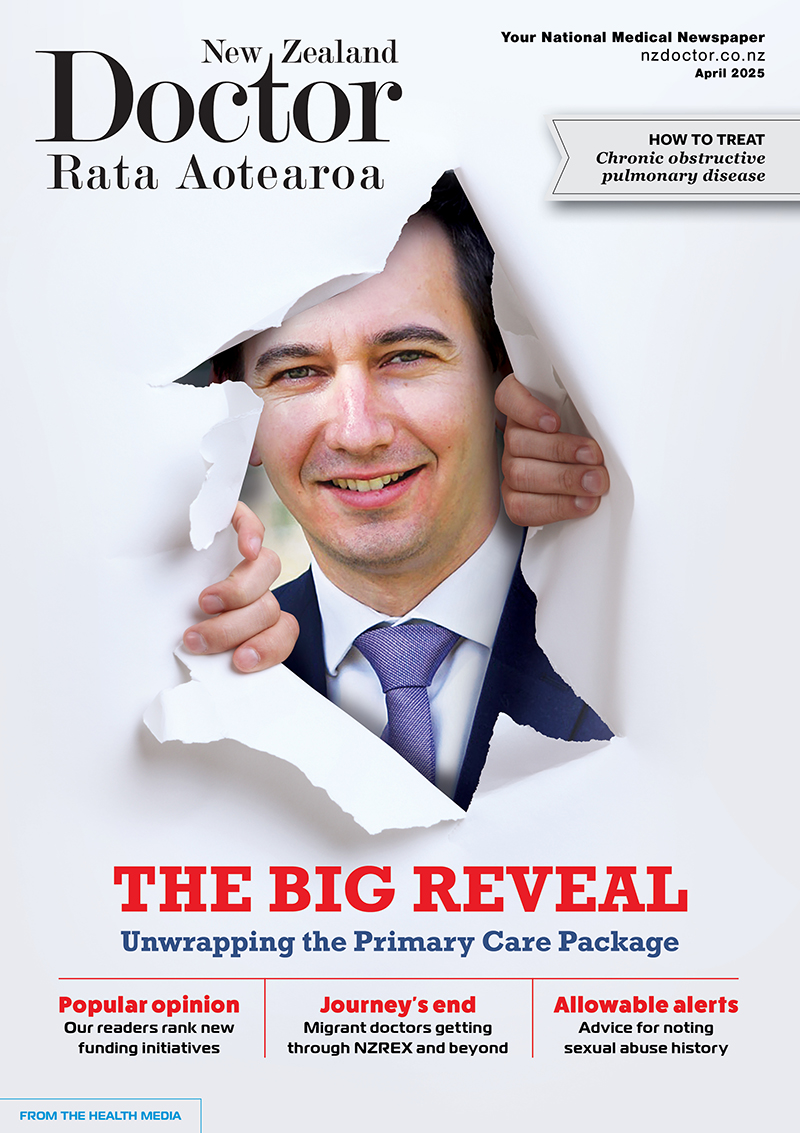Respiratory physician Lutz Beckert considers chronic obstructive pulmonary disease management, including the prevention of COPD, the importance of smoking cessation and pulmonary rehabilitation, and the lifesaving potential of addressing treatable traits. He also discusses the logic of inhaler therapy, moving from single therapy to dual and triple therapy when indicated, as well as other aspects of management
Uterine fibroids: Patient-centred management starts with GPs
Uterine fibroids: Patient-centred management starts with GPs

This article reviews the diagnosis and treatment of uterine fibroids
- Women may perceive their fibroids differently and have different treatment expectations.
- Differential diagnosis of malignancy is essential, particularly with ever-increasing conservative treatment modalities.
- Minimally invasive treatments increase the range of options available, and gynaecological input is recommended.
- Careful counselling aids women with treatment choices; discussions begin with their GPs.
This Practice article has been endorsed by the RNZCGP and has been approved for up to 0.25 credits for continuing professional development purposes (1 credit per learning hour). To claim your CPD credits, log in to your Te Whanake dashboard and record this activity under the appropriate learning category.
Nurses may also find that reading this article and reflecting on their learning can count as a professional development activity with the Nursing Council of New Zealand (up to 0.25 PD hours).
Uterine fibroids (leiomyoma) are common, benign smooth muscle tumours originating from uterine myometrial cells. They are estimated to affect 40–80 per cent of women by age 50. Fibroids are one of the most common indications for a hysterectomy. Conservative management techniques allowing women to preserve the uterus are increasingly popular.1
Differential diagnosis of malignancy should always be considered in women presenting with a uterine mass
Following a detailed medical and gynaecological history, consider whether the patient has had the following:
- abnormal uterine bleeding – menorrhagia, dysmenorrhoea, breakthrough bleeding
- symptoms of anaemia and iron deficiency from long-term menorrhagia
- pressure symptoms, such as urinary frequency, retention, constipation, tenesmus or evidence of hydronephrosis
- a history of subfertility – distortion of the uterine cavity may be associated with implantation failure and even later-stage pregnancy losses
- acute pelvic pain – this can occur in the setting of fibroid degeneration as its vascular supply is outgrown.
Abdominal and pelvic examination may reveal a firm palpable uterine mass. Fibroids may palpate as smooth and be similar to a gravid uterus, or irregular and nodular if there are multiple fibroids. Larger fibroids may distend the abdomen. The differential diagnoses include uterine causes (pregnancy, haematoma, leiomyosarcoma) and extra-uterine causes (ovarian cyst, ovarian malignancy, ectopic pregnancy, pyosalpinx, hydrosalpinx, primary fallopian tube neoplasm, pelvic abscess, colorectal carcinoma, bladder carcinoma).
There are no specific blood tests to diagnose fibroids. Depending on symptoms, tests that may help the patient workup include full blood count; iron studies; thyroid function tests; and follicle-stimulating hormone, oestradiol and beta human chorionic gonadotropin levels.
Pelvic ultrasound is an inexpensive mode of choice for a detailed evaluation of the endometrium and myometrium. It provides information about fibroid number, size and position, and about the uterine vasculature. Serial assessments can improve accuracy and positive predictive value in distinguishing benign from malignant uterine masses.
The International Federation of Gynaecology and Obstetrics (FIGO) classification system is used to classify the position of fibroids:1,2
- type 0 – submucosal, pedunculated intracavitary
- type 1 – submucosal, <50 per cent intramural
- type 2 – submucosal, ≥50 per cent intramural
- type 3 – contacts endometrium, 100 per cent intramural
- type 4 – intramural
- type 5 – subserosal, ≥50 per cent intramural
- type 6 – subserosal, <50 per cent intramural
- type 7 – subserosal pedunculated
- type 8 – other (eg, cervical, parasitic).
MRI provides more accurate morphological soft-tissue detail when compared with CT and has a valuable preoperative role in documenting the position and size of fibroids. MRI can also identify fibroid degeneration and potential sarcomatous changes.
Differential diagnosis of malignancy should always be considered in women presenting with a uterine mass, particularly if they are postmenopausal. Suspicion should increase for malignancy with rapidly growing fibroids, particularly in postmenopausal women who are not taking menopausal hormone therapy and in those responding poorly to gonadotropin-releasing hormone (GnRH) agonists. Taking tamoxifen for more than five years is associated with a threefold increase in the risk of leiomyosarcoma.
Management options depend on the symptoms experienced and the desired outcomes. Asymptomatic women, or those with small or slow-growing fibroids, usually benefit from expectant management. Women with larger fibroids who decline medical treatment and have no significant symptoms may only require growth-monitoring pelvic ultrasounds.
Tranexamic acid and NSAIDs are effective in managing fibroid-related menorrhagia. A Mirena intrauterine device can help with abnormal uterine bleeding. Depending on fibroid size and position, the associated cavity distortion may make inserting and retaining a Mirena difficult.
GnRH agonists (goserelin; Zoladex) reduce oestrogen production and may reduce fibroid size and decrease vascularity. These effects are transitory; fibroids usually grow back to the pretreatment size several months after treatment cessation. Additionally, they carry significant side effects, such as hot flushes, sleep disturbances, vaginal dryness and headaches. Long-term use (greater than six months) can predispose to osteoporosis. GnRH analogues are only recommended for temporary symptomatic relief and preoperative fibroid size reduction.
Uterine artery embolisation (UAE) involves an embolic agent introduced via angiography to occlude the vascular supply of a fibroid, causing degeneration. UAE is considered safe and minimally invasive, with demonstrable improvement in most patients’ menstrual bleeding, pressure and urinary symptoms, and dysmenorrhea.
Compared with myomectomy, UAE is associated with shorter procedural times and hospital stays, and faster resumption of usual activities. However, UAE is associated with higher rates of minor postoperative complications and an increased likelihood of surgical reintervention within two years. The overall failure rate is estimated to be approximately 32 per cent within the first two years, compared with 7 per cent of patients after hysterectomy or myomectomy. Effects of UAE on premature ovarian failure, overall fertility and pregnancy outcomes are not well established.1
Surgical options include myomectomy, a uterine-sparing procedure involving the surgical removal of fibroids from the uterine wall. Some women may require this to improve their reproductive chances if there is a suggestion that the fibroid is causing recurrent miscarriages, fallopian tube compression or significant distortion of the uterine cavity.
Myomectomy may be performed via laparotomy, laparoscopy or hysteroscopy in the case of submucosal fibroids. The laparoscopic approach is associated with decreased perioperative and postoperative morbidity and shorter hospital stays when performed by a skilled laparoscopic surgeon, particularly when compared with open myomectomy. However, this approach may have a higher recurrence rate than open myomectomy.
Mechanical morcellators are increasingly utilised in laparoscopic fibroid resection. These instruments divide tissue into smaller sections that are otherwise too large to remove via laparoscopic port sites.3
In 2014, the US Food and Drug Administration released a statement discouraging the use of laparoscopic power morcellation following a case of inadvertent morcellation of leiomyosarcoma and subsequent malignant upstaging. Large retrospective trials have demonstrated that the risk of unintended morcellation of a uterine leiomyosarcoma following preoperative selection of women with fibroids is one in 4791 women. The chances of this occuring with minimally invasive surgery should be carefully conveyed to patients. The use of contained in-bag morcellation techniques to remove fibroid masses has developed rapidly since 2014.
Submucosal fibroids can be removed hysteroscopically with a resectoscope or morcellator. They are transcervical procedures that are usually a day procedure.4 Most women avoid further surgery and experience improved menstrual bleeding symptoms, sometimes with a combined endometrial ablation. A recent Cochrane review supports hysteroscopic myomectomy improving fertility.5
Intramural fibroids may be associated with subfertility and increased miscarriage. The number of fibroids and their position should be considered individually. Any decision to manage fibroids surgically should be made using the principles of patient-centred care, with full acknowledgement of the benefits and risks. Removing intramural fibroids will create a scar in the uterine wall, similar to a classical caesarean section. As a result, patients should have an elective caesarean section for future deliveries. Consensus statements recommend that pregnancy should be avoided for six months after the initial myomectomy surgery.
Women with symptomatic fibroids who do not desire future fertility may be candidates for a hysterectomy. Complete removal of the uterus has the best outcome for symptom reduction, fibroid recurrence, and further surgery requirements. There are three main surgical approaches: vaginal, abdominal (laparotomy) and laparoscopic. A vaginal hysterectomy is the preferred option if possible. In the case of large fibroids, this may not be technically achievable.
A laparoscopic hysterectomy has similar benefits to the vaginal approach – reduced postoperative pain, better cosmetic results, shorter hospitalisation and speedier return to work. It uses expensive equipment, but hospital and postoperative care savings offset most costs when compared with open abdominal hysterectomy. Guidelines now recommend contained in-bag morcellation at laparoscopic hysterectomy for a fibroid uterus that can be performed vaginally, at the umbilicus or through a small Pfannenstiel incision.
Uterine fibroids present with various symptoms and management options. Diagnosis involves a thorough assessment, including medical history and imaging. While expectant management is suitable for asymptomatic or small fibroids, various interventions exist for symptomatic cases. Tranexamic acid, NSAIDs, Mirena and GnRH agonists can help manage symptoms, but effects are often temporary. UAE offers a minimally invasive option with notable symptom improvements. Surgical options include myomectomy, with laparoscopy showing advantages, and hysterectomy for those not desiring fertility. Patient-centred care and informed decision-making are essential in selecting the most appropriate treatment, with consideration of risks and benefits. Advances, such as contained in-bag morcellation, continue to shape the landscape of fibroid management.
Devon is a 38-year-old mother of two children who comes to see you with increasing urinary frequency and the feeling of something solid in her lower abdomen in the mornings. She has regular, normal periods and is otherwise well. At her last pregnancy, five years ago, ultrasounds noted a 5cm fibroid.
You perform an abdominal and pelvic examination, which reveals a mobile enlarged uterus that is equivalent to the size of a 16-week pregnancy. You arrange for a pelvic ultrasound, which confirms a 10cm intramural fibroid. Devon wants to know what to do next as she wants another child.
You refer Devon to the local hospital’s gynaecology department, which arranges a pelvic MRI. Due to her significant mass, symptoms and desire for further pregnancy, uterine-sparing laparoscopic myomectomy with contained in-bag morcellation is performed. She conceives spontaneously six months later and has an elective caesarean section.
Michael Wynn-Williams is the lead of the Minimally Invasive Gynaecology Service and the training director for the AGES Accredited Training Program at Auckland City Hospital; he practices privately at Ascot Hospital; drmww.co.nz
You can use the Capture button below to record your time spent reading and your answers to the following learning reflection questions, which align with Te Whanake reflection requirements (answer three or more):
- What were the key learnings from this activity?
- How does what you learnt benefit you, or why do you appreciate the learning?
- If you apply your learning, what are the benefits or implications for others?
- Think of a situation where you could apply this learning. What would you do differently now?
- If an opportunity to apply this learning comes up in the future, what measures can be taken to ensure the learning is applied?
- Can you think of any different ways you could apply this learning?
- Are there any skills you need to develop to apply this learning effectively?
1. Stewart EA, Laughlin-Tommaso SK, Catherino WH, et al. Uterine fibroids. Nat Rev Dis Primers 2016;2:16043.
2. Munro MG, Critchley HO, Broder MS, Fraser IS. FIGO classification system (PALM-COEIN) for causes of abnormal uterine bleeding in nongravid women of reproductive age. Int J Gynaecol Obstet 2011;113(1):3–13.
3. Glaser LM, Friedman J, Tsai S, et al. Laparoscopic myomectomy and morcellation: A review of techniques, outcomes, and practice guidelines. Best Pract Res Clin Obstet Gynaecol 2018;46:99–112.
4. Kroon B, Johnson N, Chapman M, et al. Fibroids in infertility--consensus statement from ACCEPT (Australasian CREI Consensus Expert Panel on Trial evidence). Aust N Z J Obstet Gynaecol 2011;51(4):289–95.
5. Metwally M, Raybould G, Cheong YC, Horne AW. Surgical treatment of fibroids for subfertility. Cochrane Database Syst Rev 2020;1(1):CD003857.
Further information: Wynn-Williams M. Uterine fibroids; from effects on fertility to the peri-menopause and beyond. Goodfellow Unit webinar. 19 October 2021.






![Barbara Fountain, editor of New Zealand Doctor Rata Aotearoa, and Paul Hutchison, GP and senior medical clinician at Tāmaki Health [Image: Simon Maude]](/sites/default/files/styles/thumbnail_cropped_100/public/2025-03/Barbara%20Fountain%2C%20editor%20of%20New%20Zealand%20Doctor%20Rata%20Aotearoa%2C%20and%20Paul%20Hutchison%2C%20GP%20and%20senior%20medical%20clinician%20at%20T%C4%81maki%20Health%20CR%20Simon%20Maude.jpg?itok=-HbQ1EYA)
![Lori Peters, NP and advanced health improvement practitioner at Mahitahi Hauora, and Jasper Nacilla, NP at The Terrace Medical Centre in Wellington [Image: Simon Maude]](/sites/default/files/styles/thumbnail_cropped_100/public/2025-03/2.%20Lori%20Peters%2C%20NP%20and%20advanced%20HIP%20at%20Mahitahi%20Hauora%2C%20and%20Jasper%20Nacilla%2C%20NP%20at%20The%20Terrace%20Medical%20Centre%20in%20Wellington%20CR%20Simon%20Maude.jpg?itok=sUfbsSF1)
![Ministry of Social Development health and disability coordinator Liz Williams, regional health advisors Mary Mojel and Larah Takarangi, and health and disability coordinators Rebecca Staunton and Myint Than Htut [Image: Simon Maude]](/sites/default/files/styles/thumbnail_cropped_100/public/2025-03/3.%20Ministry%20of%20Social%20Development%27s%20Liz%20Williams%2C%20Mary%20Mojel%2C%20Larah%20Takarangi%2C%20Rebecca%20Staunton%20and%20Myint%20Than%20Htut%20CR%20Simon%20Maude.jpg?itok=9ceOujzC)
![Locum GP Helen Fisher, with Te Kuiti Medical Centre NP Bridget Woodney [Image: Simon Maude]](/sites/default/files/styles/thumbnail_cropped_100/public/2025-03/4.%20Locum%20GP%20Helen%20Fisher%2C%20with%20Te%20Kuiti%20Medical%20Centre%20NP%20Bridget%20Woodney%20CR%20Simon%20Maude.jpg?itok=TJeODetm)
![Ruby Faulkner, GPEP2, with David Small, GPEP3 from The Doctors Greenmeadows in Napier [Image: Simon Maude]](/sites/default/files/styles/thumbnail_cropped_100/public/2025-03/5.%20Ruby%20Faulkner%2C%20GPEP2%2C%20with%20David%20Small%2C%20GPEP3%20from%20The%20Doctors%20Greenmeadows%20in%20Napier%20CR%20Simon%20Maude.jpg?itok=B0u4wsIs)
![Rochelle Langton and Libby Thomas, marketing advisors at the Medical Protection Society [Image: Simon Maude]](/sites/default/files/styles/thumbnail_cropped_100/public/2025-03/6.%20Rochelle%20Langton%20and%20Libby%20Thomas%2C%20marketing%20advisors%20at%20the%20Medical%20Protection%20Society%20CR%20Simon%20Maude.jpg?itok=r52_Cf74)
![Specialist GP Lucy Gibberd, medical advisor at MPS, and Zara Bolam, urgent-care specialist at The Nest Health Centre in Inglewood [Image: Simon Maude]](/sites/default/files/styles/thumbnail_cropped_100/public/2025-03/7.%20Specialist%20GP%20Lucy%20Gibberd%2C%20medical%20advisor%20at%20MPS%2C%20and%20Zara%20Bolam%2C%20urgent-care%20specialist%20at%20The%20Nest%20Health%20Centre%20in%20Inglewood%20CR%20Simon%20Maude.jpg?itok=z8eVoBU3)
![Olivia Blackmore and Trudee Sharp, NPs at Gore Health Centre, and Gaylene Hastie, NP at Queenstown Medical Centre [Image: Simon Maude]](/sites/default/files/styles/thumbnail_cropped_100/public/2025-03/8.%20Olivia%20Blackmore%20and%20Trudee%20Sharp%2C%20NPs%20at%20Gore%20Health%20Centre%2C%20and%20Gaylene%20Hastie%2C%20NP%20at%20Queenstown%20Medical%20Centre%20CR%20Simon%20Maude.jpg?itok=Z6u9d0XH)
![Mary Toloa, specialist GP at Porirua and Union Community Health Service in Wellington, Mara Coler, clinical pharmacist at Tū Ora Compass Health, and Bhavna Mistry, specialist GP at Porirua and Union Community Health Service [Image: Simon Maude]](/sites/default/files/styles/thumbnail_cropped_100/public/2025-03/9.%20Mary%20Toloa%2C%20Porirua%20and%20Union%20Community%20Health%20Service%20in%20Wellington%2C%20Mara%20Coler%2C%20T%C5%AB%20Ora%20Compass%20Health%2C%20and%20Bhavna%20Mistry%2C%20PUCHS%20CR%20Simon%20Maude.jpg?itok=kpChr0cc)